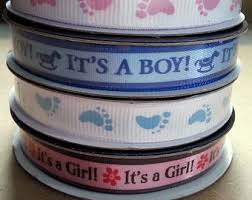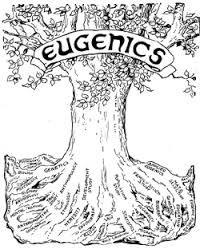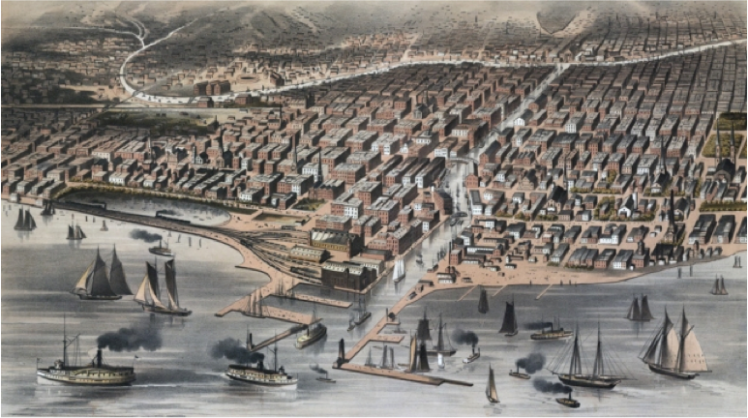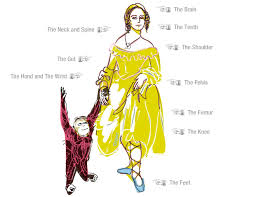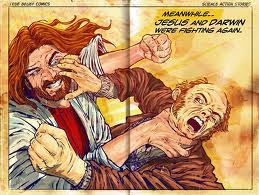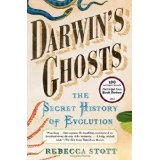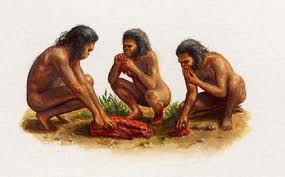WHY DO WE LOVE STORY? (Part II.)
We are nearing the end of the semester, but I asked the class to re-visit, in their minds, the summer before they were freshmen at EIU. As a new student, they filled out countless forms, paper and electronic, that pertain to this school: the Panther card, the parking permit, the online access to D2L. Other than being tedious, all of these activities have at their core writing. Writing, which is so often considered a door that opens into a creative journey, was first created out of need, as was all basic inventions. The need was to organize people in one of our other great inventions: the city.
One of the earliest pieces of writing is this clay tablet found in what is modern day Iraq.  What treasured bits of poetry is found here? None. The tablet documents the allocation of beer to workers. In other words, one of the first examples of writing is a time card.
What treasured bits of poetry is found here? None. The tablet documents the allocation of beer to workers. In other words, one of the first examples of writing is a time card.
The history of writing is too great to explain here, but I’ll hit upon some key points. We have Socrates who warned that writing down speeches would make us weaker. (In fact it was his student Plato who wrote down his speeches.) We have the era when writers were simply scribes and the wealthy need not learn this specialized skill, similar to how I don’t bother to learn plumbing seeing as how I can call someone to the job. Much later, we have the invention of the novel, which many feared would ruin our minds and then the horrible addition of female novelists such as Jane Austen.
The truth is, writing and literature have only further developed our minds and made opportunities where we could not previously conceive of them.
We then turned our attention to Jonathan Gottschall’s book, The Storytelling Animal: How Stories Make Us Human, that explores a problem posed in the preface: “We do not know why we crave story. We don’t know why Neverland exists in the first place. And we don’t know exactly how, or even if, our time in Neverland shapes us as individuals and as cultures. In short, nothing so central to the human condition is so incompletely understood.”
By using biology, psychology, and neuroscience, Gottschall attempts to answer why story has such a hold over us. As we discussed in the last blog, we spend inordinate amounts of time in the realm of story—some research claiming as much as 2/3 of our time, if we include dreaming. But we don’t know why we do that. Here are some possible reasons that Gottschall’s book, and our class, explored:
- Sexual selection. In other words, telling good stories helps people acquire mates and therefore reproduce.
- Stories are a form of cognitive play. This type of work helps the mind prepare for future problems the way exercise helps keep the body in shape.
- Stories are low-cost sources of information. They are meant to instruct, even when they might seem banal. Think of that classic scene featuring the double-chip dipper from Seinfeld, the show some say is about nothing. One could argue that even that silly moment is one of instruction: double dipping is unsanitary.
- The mind is adept at detecting pattern, which is incredibly beneficial to us. And story is one way to hone that very necessary skill. Example: understanding the pattern of the stars enabled many a sailor to find his way home. If you think about it in a certain way, the alphabet is process of recognizing pattern.
In fact, we are known to create story where there is none, a fact exemplified by this 1944 experiment by Fritz Heider and Marianne Simmel. It just lasts two minutes, so watch it and see if you can correctly answer the question: What do you see? Only 3 out of 114 participants answered correctly. (I’ll post the correct answer at the bottom of this blog. No peeking!)
- Story is a form of social glue that brings people together, similar to sports and religion.
- Story is for nothing at all. Or another way to say this is that stories are escapist. But let’s think about that…. What is the central thread that runs through every story? Conflict. Trouble. If story were truly escapist, then wouldn’t it be a whole lot softer and fuzzier, like, let’s say, internet pictures of kittens?
Just the other day, I was driving my two-year-old to the library, and she started wailing from the backseat that she didn’t want to go there. “Why not?” I asked. “There are lions there. They eat me.” I started to coo and soothe, saying oh no, lions do not live within the library stacks, at least not in the children’s section, when she scowled: “Pretend, Mom. Pretend.” It was hard to imagine that this child would rather imagine running from lions than running toward a warm library on an unusually cold November.
Granted, there is no right answer, or at least, we don’t know the answer now. But this is one question that literary evolutionists are trying to answer. Our next class will receive a visit from one of Literary Darwinism’s founders: Joseph Carroll. As I have said before, we are thrilled to have him come talk to our class about his interdisciplinary approach. (Thank you to the Redden Fund and the Humanities Center at EIU for the grant!) I’ll be sure to report back on what he says in answer to this question.
(Answer to video clip: Geometric shapes are moving on a screen. There is no story.)
WHY DO WE LOVE STORY? (Part I.)
On Thursday, we began our new topic for the next two weeks, which is the subject of literary evolutionism. Seeing as how this segment of the course investigates the reach of Darwin’s ideas into the Humanities, it’s only fitting that we explore this growing group of academics who are interested in how literature reflects Darwin’s theories of natural selection and its related field of gene-culture coevolution. In fact, our class is fortunate to have Joseph Carroll, one of the founding fathers of this school of criticism, visit in two weeks! 
There are a lot of different types of literary evolutionists, or literary Darwinists, but one question that some literary evolutionists are investigating is why do we read? Why do we love story? I began by asking the class how much of their daily lives are spent in the realm of story—if one opens that up to daydreaming; watching movies, TV, or music videos; listening to songs; and those old-fashioned things called books. Within my class of twelve students, many said that they guessed 50-80% of their lives revolved around story.
I don’t know if my students are all that different from the public. Jonathan Gottschall, author of The Storytelling Animal, has estimated that we spend about five hours per day “awash in the glow of television and movie screens.” But if you broaden the definition of story to include songs, daydreaming, and reading, it would be even more. So, if we are spending so much of our time surrounded in story, what do we get out of it?
One psychology study recently reported in the New York Times said that those who read literary fiction (as opposed to mass-market fiction) have better social skills. “…People performed better on tests measuring empathy, social perception, and emotional intelligence—skills that come in especially handy when you are trying to read someone’s body language…”.
Study participants read some Chekhov, so I asked the class to read “Lady with Lapdog.” We spent an hour moving through this story and looking into this sad affair between two married people in the late 1800s. Neither person was happily married, but neither had a way to get out of it. It was 1898, after all. Our class quickly recognized the bind the characters were in. The discussion did not revolve around condemnation as the story presented too much complication for that. Instead, we focused on small details, trying to articulate when Dmitri Gurov moved from passion to true affection in the story, trying to articulate when Anna Sergeyevna realized she was worse off than before. In other words, we practiced reading people.
And that was the point of the article. The test (whose results have been recreated in other experiments) found that those who read literary fiction were better at reading “people’s eyes.”
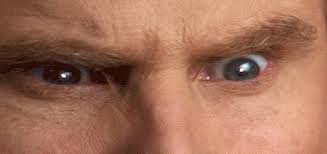
Here’s how the experiment was done: “People ranging in age from 18 to 75 were recruited for each of five experiments. They were paid $2 or $3 each to read for a few minutes. Some were given excerpts from award-winning literary fiction (Don DeLillo, Wendell Berry). Others were given best sellers like Gillian Flynn’s “Gone Girl,” a Rosamunde Pilcher romance or a Robert Heinlein science fiction tale.”
What might be surprising to some is that those who read nothing scored the same as those who read lighter fare like Gone Girl. “Literary fiction readers also scored better than nonfiction readers — and popular fiction readers made as many mistakes as people who read nothing.”
Tuesday’s class was a sex-education lecture that none of us had quite had before. Dr. Fritz opened it up by giving us a little reminder about what Darwin has contributed to our understanding of gender and sexuality. The simplest way to put it is this: Darwin cracked open the little nut of belief called essentialism, which is the idea that everything and everyone does not change, that there are a set of attributes essential to one’s identity and function. This comes partly from Plato, if we go way back in time. Plato proposed the idea of infinite time with a perfect universe in perfect harmony (whatever that might mean). And we see the Christian church later embracing this idea with two perfect people, ol’ Adam and his Eve, in a perfect sun-always-shining Eden. In this construct, organisms changing into other organisms (i.e. dinosaurs evolving into the yellow-bellied sapsucker outside my office window) are not a possibility. If you think about it a certain way, change is the opposite of perfection.
So, how does this relate to gender determination? For humans, and most mammals, one gene—the “y” chromosome—has to be turned on to go down the path to becoming male. When that gene turns on, it turns on a series of other genes. But until five or six weeks of age, a human embroyo has the materials to become either sex. The picture below gives a sense of what one’s anatomy looks like at this stage–and then how it develops. One can see how the same parts morph into something else later on in life.
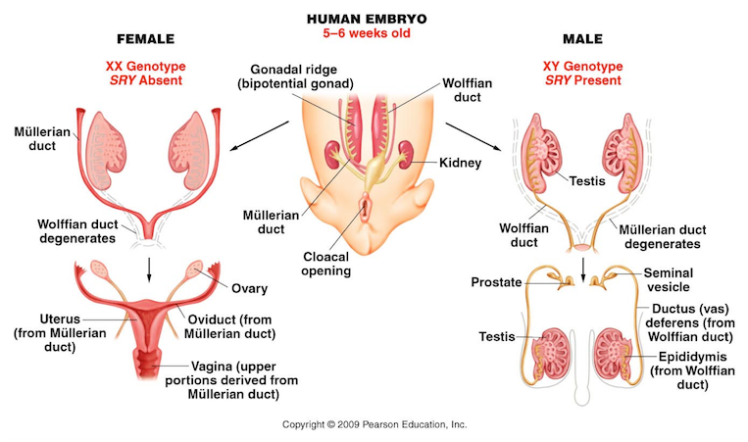
But there are many different stages and different cells that have to be turned on all along the way. And there are various stages of sex, too. There’s genetic sex, gonadal sex, phenotopic sex, meaning that at each of theses stages, another type of development generally occurs. But not necessarily. As Dr. Fritz keeps reminding us, with slide after slide, there are examples of everything in the natural world. Women with penises, people born with both vaginas and penises, women with full beards, etc. Aside from physiological differences, there are all sorts of combinations of sexual preferences, too: men who feel like women but who prefer men; women who are attracted to men most of the time, but not all the time; men who primarily like women; and men and women who have no or very low sexual desire toward anything or anybody, etc.
His point was this: we as humans like categories. We have created the category of categories. But in biology, it’s all about recognizing how things generally work and accepting the shades of grey. Darwin helped us start to see that variation is not only natural, but a fact of life.
I’ve included here a chart, a very un-sexy chart, that shows various stages of development, just to give you a sense of the complexity of this thing often reduced to blue and pink ribbons.
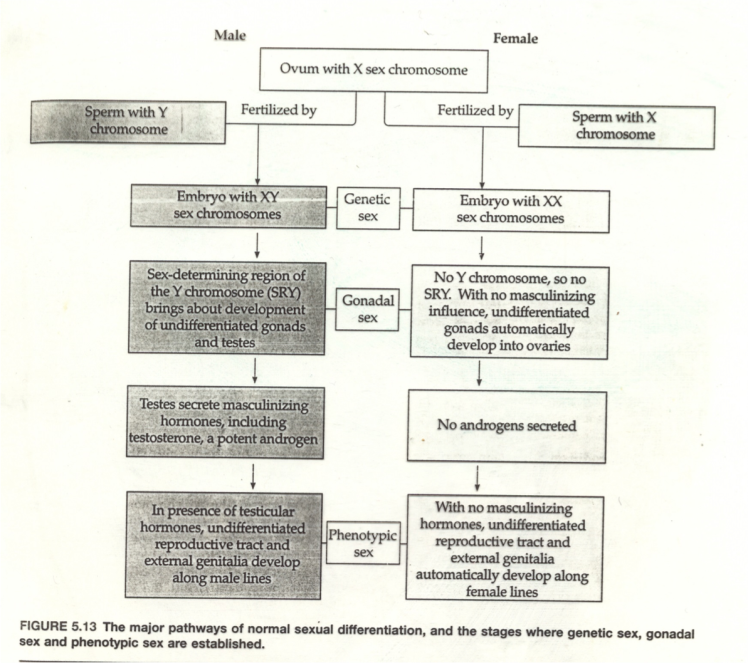
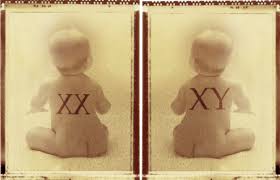 Gender and Sexuality from a Biological Perspective
Gender and Sexuality from a Biological Perspective
On Tuesday’s class, we moved into another effect of Darwin’s principles—and that involves our understanding of gender construction and sexuality. During Darwin’s time, gender roles were very much set in stone. The woman’s role centered around the home and raising children and the man’s role centered around the land and generating income.
But as Darwin illustrated with example and example, variation is the one consistency in the natural world and animal kingdom. So, if variation is the one constant variable, what does that mean about gender? And about sexuality?
Darwin’s theories opened the doors to the idea that gender is not simply a binary between male and female but a spectrum of everything in between. We have just begun delving into this topic, but to help us see examples along the spectrum, I gave the class a few poems that presented speakers with a variety of sexual preferences and proclivities. We read contemporary poets Bradford Tice, Sharon Olds, Gary Soto, and Keetje Kuipers. The only consistent thread to all of the poems, and to Darwin’s theories, is that everything and everyone is always in a state of flux.
From a biological perspective, humans are a single species, but we (as a species) exhibit a variety of sexual identities, preferences, and sexual characteristics–not just two, male and female. So, this notion of an idealized man or woman is biologically a falsity as nothing, not even natural selection, moves toward a sense of “progress” or “perfection.” That would be called teleological evolution—this belief that we are always progressing. Darwin was very firm this was not the case. Instead, plants and animals respond to what suits their particular needs and their particular environment based on their own strengths and inclinations, which varies from individual to individual. The only thing we know for sure is that we are always changing.
On Tuesday, Dr. Fritz finished up the segment on eugenics, which is the belief and practice that humans can improve the gene pool by advocating reproduction with those of “higher” traits and suppressing reproduction of those with “lower” traits.
It was fascinating to listen to Dr. Fritz condemn eugenics because how he approached the subject was quite different from how I would have coming from the Humanities. Whereas I might lead the discussion with emotional appeals for common decency and logical concerns about how one determines what is “better” or what “better” even means, Dr. Fritz condemned eugenics with a mathematical formula. That’s right: math.
He had the class imagine that we, as a country, were going to practice eugenics and kill anyone with PKU, which is one of the most common inherited diseases. Upon birth in a hospital, every newborn’s heel is pricked and tested for this disease.
To understand the mathematic formula, one needs to remember that it takes two genes for genetic diseases to manifest. In other words, you may have a recessive gene for PKU, but the recessive gene alone doesn’t give you symptoms. One in 12,000 people will have this disease, which is a frequency of .0000833. Dr. Fritz did the numbers and showed that if we kept killing the people who have the disease, it would take 1,000 generations to wipe it out.
So, set outside issues of morality. Set aside issues of feasibility such as who does the rounding up and how. Just logically, eugenics is not a feasible method to “improve” the population because of how recessive genes work. Everyone, absolutely everyone, has a predisposition for something. We have 25,000 pairs of genes in a single body. All of us have some mutations within that 25,000. In other words, as Dr. Fritz pointed out, if you want to suggest killing off the imperfect people, start with yourself.
INDUSTRIALIZATION AND DARWIN
Dr. Malgorzata J. Rymsza-Pawlowska, a cultural historian who specializes in the 19th and 20th centuries, visited class on Thursday to discuss social Darwinism, eugenics, and scientific racism. An energetic and engaging speaker, Dr. Rymsza-Pawlowska first showed us pictures of Chicago’s waterfront, one from 1820 and one from 1870 to remind us that Darwin’s publications coincided with another huge change: second-wave Industrialization in the U.S. With the widespread use of the steam engine to power trains, boats, and factory machinery, Industrialization created a different social structure. People moved from their family’s farms to seek jobs in the cities. Now, products could be bought instead of made. Now, reputations could be created instead of inherited. Now, individuals could follow personal aspirations. But with these shifts, many of which were liberating, also came anxieties. Who were all these people flocking to the cities from all over the world? How did one find community? How did one express individuality? And how is hierarchy established within all this anonymity?
Questions of hierarchy due to industrialism are compounded by Darwin’s works that suggest nature has far more influence than previously understood. While historians are careful not to suggest causality, Dr. Rymsza-Pawlowska mentioned how fashion, brands, baby books, and photography all became increasingly popular during this time when people were concerned with status and how to quickly communicate it. And unfortunately, some latched onto racist ideas such as proposing that the shape of one’s forehead (phrenology) was an indicator of intelligence. Big surprise, the brow of the Englishman was an indicator of the highest intelligence, which is how we got the term “high-brow.” Other examples of pseudo-science include this misapplied idea of “survival of the fittest” to help rationalize behaviors of aggressive industrialists. All of this makes me think about pseudo-science today—and just how dangerous a poor understanding of science can be as we are currently seeing with climate change.
 THE UGLY SIDE: SOCIAL DARWINISTS
THE UGLY SIDE: SOCIAL DARWINISTS
Today, Dr. Fritz began talking about a dark side effect of Origins—and that is the idea of social Darwinism. Coined in the late 19th century, this term describes the idea that humans compete to survive, similar to plants and animals. Misunderstanding Darwin’s idea of “survival of the fittest,” social Darwinists rationalize racism, imperialism, and the negative effects of capitalism as simply effects of living.
You may recall that On the Origin of Species focused on plants and animals, not humans. Darwin’s later book, The Descent of Man (1871), did discuss man’s origins, but still. “Fit” from a biological standpoint simply means that one’s offspring successfully breed. So, if we define “success” as having one’s kids have kids, that hypothetical welfare mom that social conservatives love to attack would actually be at the top of the social ladder.
While social Darwinism was most popular at the turn of the 20th century, it rapidly lost traction after WWI and was further discredited by the rise of Nazism and eugenics.
Where does it all stand now? I still hear the phrase “survival of the fittest” to swipe away real problems such as inequitable distribution of resources. I even hesitate to talk about how much I appreciate what Darwin has contributed to science because I fear others will think I’m a social Darwinist. Darwin, however, never implied that we should not help one another.
Mrs. Darwin
7 April 1852.
Went to the Zoo.
I said to him—
Something about that Chimpanzee over there reminds
me of you.
By Carol Ann Duffy from her Selected Poems. (It’s midterms. We could all use a little levity.)
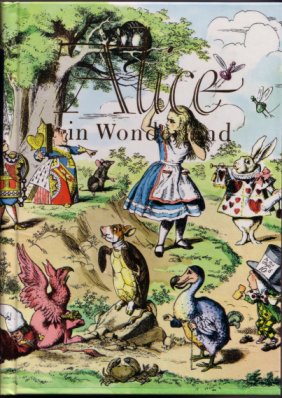 WHAT’S THE CONNECTION BETWEEN ALICE AND DARWIN?
WHAT’S THE CONNECTION BETWEEN ALICE AND DARWIN?
When I handed out today’s reading, which was selections from Alice in Wonderland, I asked the class to do two things: read it–and come up with an hypothesis as to why we were reading it. Published just six years after Origins, it’s hard to imagine that the kerfuffle hadn’t reached Lewis Carroll. While Carroll did not respond directly to the debates regarding evolution in this children’s book, Carroll does present a post-Darwinian understanding of nature, man, and survival. But how?
I divided the class into groups of two and gave each group a topic to explore. The topics included: Struggle for Life, Agents of Change, Continual Change, Predator vs. Prey, and Hierarchy. For each topic, I asked them to find at least three examples and try to figure out if there was a pattern to those examples. Let’s consider, for instance, how hierarchy is established in Alice. Or is it even established? The King and Queen of Cards may be in charge of the trial, but they make no sense at all, asking first for the sentence and then the verdict, for example. During the trial, as Alice grows taller and taller, she begins to contradict them more and more. So, maybe Alice is in charge? But there are multiple times when the animals don’t give her that sort of respect such when the Hare and the Hatter argue with everything she is saying. The only times when Alice appears to be at the top of the hierarchy are when she is physically able to dominate. But there are exceptions to that, too, that often depend on chance. (Will she survive the fall down the hole? All depends on the hole itself, the speed, what’s at the bottom—factors that she cannot control.) What’s clear is this: the idea that humans are separate from and above all other animals is not a given in this story, and that is one of the many ripple effects from Origins. Nature is in charge. Chance is in charge. Sometimes Alice is taller and sometimes Alice is smaller. Again, nothing and no one is static, but instead in a constant state of flux depending on natural causes—or as Darwin said—natural selection.
For Tuesday’s class, Dr. Richard England, Dean of the Honors College, guest lectured about the religious reaction to Darwin’s work in the years following Origin’s 1859 publication. His point was not what you’d expect. Contrary to the current pugilistic tenor that one must swiftly choose between God or Darwin, the late 19th century offered a variety of nuanced reactions.
Before I go on, I must say what a wonderful speaker Dr. England was. One of his degrees is in the history of science, so clearly, context and reaction is his arena. But what was most impressive was how his questions allowed the class to embrace the line of reasoning a 19th century naturalist might have used. For example, Dr. England reminded us that Darwin’s world was less secular one in which we currently live. Worshipping God occurred not only through the study of the Bible, but through the study of nature. How did that work? Dr. England illustrated with what he had, which happened to be a purchased cup of coffee. “Take, for instance, this cup of coffee that I hold in my hands. How do you know it was designed?” Dr. England asked. We all stumbled about a second, unsure how to articulate something that was such a given. But finally, the details came: the waxy liner held in the liquid, the cup “koozie” protected hands from the heat, the slanted walls facilitated flow to the lips, etc. We really looked at what was before us to better understand it. In Darwin’s time, many adults and children did this as a way to not only understand the world, but as a way to understand (and marvel at) God’s decisions and designs.
So, what were some of the responses to Origins from religious people? Asa Grey, a friend of Darwin’s and an American botanist, believed God had directed the variations. Darwin, however, believed that it was all much more random. (One can view their civilized discussions through the Darwin Correspondence Project, which is editing and publishing the more than 12,000 extant private letters written by Charles Darwin). Other views included the Neo-Orthodox idea that God didn’t need to involve himself with such things. Progressive Evolutionists thought God to be in charge as long as there was “progress,” an idea that many today very much dispute. (There is no progress toward “perfection,” for what is perfection? It’s all about what is better for one’s conditions. My hands are wonderful for typing, but quite useless in combat with a bear. A bear, though, wouldn’t be able to type as fast as I can.) Aubrey Moore, one of the first Christian Darwinists, believed that God is in all places at all times and that the natural selection was actually more “Christian” than the theory of Special Creation. Those were just a few of the people that Dr. England named.
The point is that the current portrayal of this subject is one that generates more heat than light. And we are worse off for it. Let’s reserve our drama for movies and preserve our dialogue for true discussions.
 MOVING INTO CONTEXT AND RECEPTION
MOVING INTO CONTEXT AND RECEPTION
We have now finished the class’s first segment that looked at what Darwin proposed in On the Origin of Species. For the next few weeks, we are discussing the historical context and public reception of those ideas. Our class on Thursday discussed poems responding to Darwin’s theories in some way. The poems included: “Mutability” and “Lines Composed a Few Miles above Tintern Abbey” by Wordsworth (both pre-date Origins); “Hap” by Hardy; “Dover Beach” by Arnold; “Design” by Frost; and a contemporary poem “Dover Bitch” by Hecht.
In most of these selected poems, what we are seeing is a crisis of faith, a doubt that there may be a kind and ever-watchful God governing our world. Because of Darwin’s papers, many people found themselves at a loss. The sense of loneliness in “Dover Beach” and even anger in “Hap” all show various attempts at reconciling religion, science, and purpose in one’s life.
I also included a very recent poem, “Spirit in the Dark” by Robert Gibb to serve as contrast to this sense of upheaval expressed in many of the Victorian poems. In Gibb’s poem, two people are listening to Beethovan’s Ninth when they feel “something else enter the air.” The video poem depicts a ghoulish hand touching the record player, but I’m not sure if the poem itself is as direct. There is definitely fog, a sense of the dead, but the witnesses are not even sure: “What was that?” our expressions asked. / Decades later, I’d still like to know. // And what changes, if any, were played / upon us? And did any of them take?” Here, we have a speaker experience something very strange, and the response is one of accepted ambiguity. Understanding the limits to one’s knowledge and one’s interpretation of events is a given. Unlike the crisis of faith that many people felt in the Victorian era, I feel like I respond to new information, new discoveries, new perspectives with interest, but rarely feel shaken. Is that for the better? For the worse? I can’t say. But what is clear is that Origins changed how we place ourselves in the universe, even if we haven’t read a word of the text.
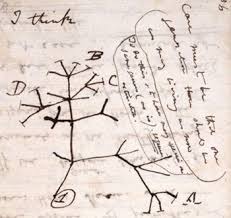 DARWIN: EQUAL PARTS PREACHER, PROPHET, AND PROFESSOR
DARWIN: EQUAL PARTS PREACHER, PROPHET, AND PROFESSOR
For today’s class, we looked at the conclusion, or what really feels like the firework finale, of On the Origin of Species. Whereas the previous 480 pages are carefully, exhaustively, even at times hesitantly proposing natural selection and descent with modification, the conclusion changes in tone. Confident and assertive, the Darwin in the last chapter is equal parts preacher, prophet, and professor. Here in the last chapter, he finally uses the word “evolved”—which is also the ONLY time he uses it in the book. (The word “evolved” has only recently been meant as a stand-in for Darwin’s life work on natural selection and descent with modification.) Honestly, the last sentence is truly beautiful: “There is grandeur in this view of life, with its several powers, having been originally breathed into a few forms or into one; and that, whilst this planet has gone cycling on according to the fixed law of gravity, from so simple a beginning endless forms most beautiful and most wonderful have been, and are being evolved.” The crescendo of the building clauses, the careful use of passive construction so as not to say who (or what) is doing the breathing or the creating, and the strong stressed final beat of “evolve” all give this final sentence its glory.
As interesting as this text is, I’m not really sure who reads it anymore. Yes, those who are intellectual curious about the subject will read it. But biology students, whose entire school is built on Darwin’s principles, don’t really need to read it as they are applying the ideas. And those who love literature maybe don’t teach it out of a fear that they don’t understand science enough. I know I wondered how my class, which is composed of not a single English or biology major, should approach it. In the end, I decided to analyze the text not so much as a scientific document, but as a rhetorical one. Here are a few questions that I asked the class and that stimulated some good discussions:
1. Compare and contrast the first edition and the final edition’s last sentence. What was changed? What are the effects of those changes?
2. How would you characterize Darwin’s tone? How does he create that tone? When does he deviate it from it?
3. Consider how Darwin structures this book. He doesn’t begin with anything explosive, but instead talks about domestic animals and breeding them for certain traits as a way to make something unfamiliar, familiar. What if, though, Darwin would have begun with the conclusion? What effect would that have on the reader?
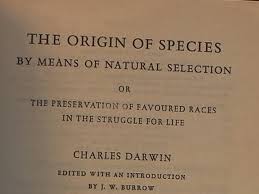 THE MYTH OF THE CRAZED SCIENTIST
THE MYTH OF THE CRAZED SCIENTIST
For Thursday’s class, I asked everyone to read chapter three of Origins. Now, this is a book that is not a cuddle-in-bed page turner. It’s thorough. It’s slow. It’s super-specific, but all for good reason. Darwin knew he had a tough rhetorical challenge and establishes himself as a man whose ideas are created from the facts. I wanted them to experience first hand Darwin’s inexhaustible methods and style. To help explain his point about the struggle for existence and that more die than can succeed (“success” solely defined by propagation), the man took a 2×3 foot piece of ground that he “dug and cleared, and where there could be no choking from other plants.” He then counted all the native weed seedlings that came up. Out of the 357 seedlings that he counted, “no less than 295 were destroyed, chiefly by slugs and insects” (67). Imagine having the patience to do not only that, but the hundreds of other mundane tasks that went into his research.
Just as a matter of circumstance, we had to finish our discussion of Frankenstein on the same day we read from Origins. No two depictions of a scientist could be any different. One who is crazed versus one who is reasonable. One who barely discusses process versus one who writes hundreds of pages on process. It’s interesting how often the fabricated one—that of the crazed scientist—is perpetuated in movies, cartoons, and books instead of one who counts seedlings. Obviously, a seedling-counting scientist doesn’t make for good TV.
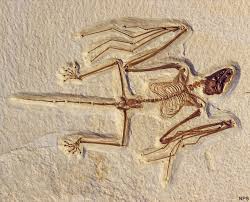 THE EVIDENCE FOR EVOLUTION
THE EVIDENCE FOR EVOLUTION
We are now moving into the evidence for evolution. This can be an emotional time for some. As I sat in my desk, taking notes with the students, watching slide after slide of evidence go by, I sensed how overwhelming lectures might feel. Sometimes, it can be an hour and fifteen minute parade of what-I-don’t-know. Dr. Fritz, however, does it in a way that’s quite palatable; he provides a few main points and loads up on the examples.
Like Darwin, Dr. Fritz is breaking it all down very slowly. I’m not about to try to list the evidence for evolution on this blog. I am a poet, after all, and countless books have been written on this subject. I do, however, just want to say how much I enjoyed Fritz’s method.
Dr. Fritz began explaining what Darwin had to counter. In Darwin’s day, the Theory of Special Creation held that species are 1) Created independently of each other 2) Do not change 3) Created Recently: 4004 BCE, the 26th of October at 9 a.m., to be exact, according to Archbishop James Ussher’s Old Testament genealogies. So, just a refresher from before…. Scientific theories have two components: first a statement of fact—like a claim about a pattern. The second component is the claim about how that pattern/process exists.
The evidence that Darwin used to show that species are interrelated and that they have changed included observable small-scale evolution called microevolution; fossils (which show extinction and change); and vestigial structures (like how we get goosebumps when afraid. When we used to have more hair, we’d look bigger when frightened or threatened. Now, we just look, well, cold.) DNA has also now corroborated the first two points. As for the third, that will be discussed next Tuesday.
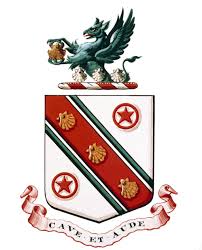 HOW ONE IS FLAMED IN THE 1800s
HOW ONE IS FLAMED IN THE 1800s
As I mentioned on Thursday, Dr. Erasmus Darwin’s poetry suggested that life originated in the sea. In fact, Erasmus had a thing for fossils and sea shells as he sensed that the earth’s history could better be understood by studying these objects. And as chance would have it, the Darwin family crest actually featured three scallop shells. Erasmus, briefly, added a motto to the crest: E Conchis Omnia—Everything from Shells. He drove around Derbyshire’s countryside in his newly adorned carriage that carried this motto, conducting his house calls—and scandalizing the neighbors. The motto sparked the following poem from a neighbor. The idea that neighbors would critique one another through heroic couplets…. Could anything be more 19th century? Love it.
Here is the poem:
He too renounces his Creator,
And forms all sense from senseless matter;
Makes men start up from dead fish bones,
As old Deucalion did from Stones;
Great wizard! He, by magic spells
Can build a world of cockle shells;
And all things frame, while eye-lid twinkles
From lobsters. crabs and periwinkles;
O Doctor! Change they foolish motto,
Or keep it for some lady’s grotto;
Else they poor patients well may quake
If thou no more canst mend them make.

 THE CONNECTIONS BETWEEN FRANKENSTEIN, DARWIN, AND PASTA
THE CONNECTIONS BETWEEN FRANKENSTEIN, DARWIN, AND PASTA
In Thursday’s class, we looked at two texts—Mary Wollstonecraft Shelley’s Frankenstein and Erasmus Darwin’s poetry. The intent was to examine the intersections between biology and literature. The representation of science in poetry or science in literature is a fascinating subject—and one that I play with. But in the 1800s, before the sciences became so specialized, there was a considerable amount of discussion or interplay between writers and naturalists. For example, we read a few poems by Erasmus Darwin, yes Charles’s Darwin’s grandfather, who presented his ideas on the origin of life in heroic couplets. Here’s one excerpt from Temple of Nature (published in 1803):
“Organic Life began beneath the waves….
Hence without parent by spontaneous birth
Rise the first specks of animated earth.”
Erasmus, who was a doctor, a naturalist, and a lover of fossils, had a hunch that life began, as he described above, in water. In fact, his experiments to try to prove this inspired Mary Shelley to write Frankenstein.
The well-known legend goes that Mary Wollstonecraft Shelley (then Mary Godwin), Percy Shelley, and John Polidori had gathered together to meet up with Lord Byron in Geneva. The weather, though, was cold and rainy, so they were stuck inside, becoming a bit bored and restless. Polidori suggested they have a competition to see who could write the best ghost story. As they talked about this idea, Shelley, who was an admirer of Erasmus Darwin’s poetry, told them of one of his experiments: that by mixing water and flour, he had taken a dried out organism and made it move. He had created life. I’m not sure how the misinformation happened, but Mary Godwin thought she heard the word “vermicelli.” The pasta. But no. Darwin had experimented with “vorticellae,” which is a microscopic aquatic filament that lives in lead gutters.
I placed above two pictures–one of vermicelli and one of vorticella–more out of cheekiness than anything. Ultimately, it did not matter that Mary confused the facts. What she was responding to was the idea—the fear—that man could create life. While Frankenstein may be considered by some the first science-fiction novel or the first to give us the stereotype of the mad scientist, I’m struck by how some of us are still grappling with the same fears presented in a text from 1818.
 OH, THAT’S JUST A THEORY
OH, THAT’S JUST A THEORY
For those of us in the Humanities, anything that smells like a belief in “truth” is suspicious. What is “truth?” Who decides that? Isn’t all “truth” just a construction? Well, let’s pause from these questions common in the Humanities and ask: what does “fact,” “law” and “theory” mean from a biological perspective? This little word “theory,” for instance can cause a lot of trouble. Its meaning in the sciences is very different from how it seems to be used otherwise. Poor “theory.”
The following are quotes from Dr. Fritz’s class lecture.
Fact: In science, a fact is an observation that has been repeatedly observed/confirmed. (Facts, however, don’t ultimately have to be true, but they could be.)
Example: structure of a cell membrane.
Law: A descriptive generalization about how some aspect of the natural world behaves under certain circumstances. ….But like all elements of science, they can be altered with new information and observations.
Example: First law of thermodynamics states that energy cannot be created or destroyed—just transformed from one state of being to another.
Theory: In science, theory is an explanation proposed for some aspect of the natural world that can incorporate facts, laws, inferences, and tested hypotheses.
Another way to look at theory is an explanation for how facts function. So, is evolution a fact or a theory? It’s both. The fact is that organisms change. The theory addresses HOW the organisms change.
What are the applications of all this for those of us not in the sciences? When someone says casually, “Oh, that’s just a theory,” as a way to diminish what is being said, it’s a misunderstanding of what theory in science actually means. Would you brush aside the idea that the sun is the center of our universe? Well, that is the theory of heliocentricity. What about the idea that germs make us sick? That’s the theory of germs. What about that all matter is divisible by atoms? That’s atomic theory.
A theory in science is not simply an idea, a hunch, or a hypothesis. Theories in science are explanations for how things work that have been tested and re-tested.
For the first two weeks, Dr. Fritz is talking about what exactly is natural selection and artificial selection. This is what Darwin painstakingly described in On the Origin of Species. And he did so very carefully, avoiding references to humans for the most part. So, no talk about us coming from apes in this book. If you are curious about what is artificial selection (think wiener dog versus sheep dog) and natural selection (white bears in snowy regions versus brown bears in forested regions), check out Cosmos: A Spacetime Odyssey’s second episode. It explains it much better than I could—and can be streamed on Netflix. (I cannot love this series more.)
After Dr. Fritz explained the concepts within Origin, I spent Thursday’s class talking about Darwin the man. The class read the preface and first chapter from Rebecca Stout’s Darwin’s Ghosts: The Secret History of Evolution. This chapter is set right after Origin’s publication during Christmastime at the Darwin family home, Down House. Darwin is tormented with eczema and anxiety about the book. His daily mail bag has tripled, his wife is asking him to stop worrying, get out of his study, join the family—but his mind is not there. Instead, he’s worried about his intellectual predecessors. What he had forgotten to do, and what many naturalists and scientists were then writing to him about, was include a historical sketch explaining whose ideas had come before his—and made his theory possible. This was later remedied in the third edition and the American tradition. But what a mistake. What’s worse, Darwin had meant to include this list of scholars, had even started writing a list of names a few years earlier. But in the rush to publish quickly so as to beat Alfred Russel Wallace—who had also come up with a similar theory—Darwin had forgotten to include this list. So human. In the end, Darwin included thirty-eight names in his historical sketch and another eight European evolutionists in a footnote. I encourage anyone to read the historical sketch as it is a great reminder that “theories” in science aren’t something just concocted in a moment of genius or inspiration. Perhaps a hypothesis is. But a theory, no. That’s something we will talk about more on Tuesday.
For now, I’ll end with this quote by Virginia Woolf: “Masterpieces are not single solitary births; they are the outcome of many years of thinking in common, of thinking by the body of the people, so the experience of the mass is behind the single voice.”
I approached Dr. Gary Fritz about creating this class last fall, right when I came to EIU. But why? I’m a poet. I basically write about my window: what’s outside it—and what’s beside it, which is my own head.
Sometimes, though, I can acutely feel the limits of what I don’t know.
Five years ago, I started writing this poem, which would later end up being a twenty-page poem that won the Black River chapbook competition. Here’s the beginning:
What small mammals
did we roast in the fire?
What first story did we
tell? Something about
longing. About loss:
The big one.
The Got-Away.
Within those few lines, I was trying to understand something about myself that my background in literature and creative writing hadn’t quite prepared me for. What have been the major events of our evolution? When did we acquire speech? The ability—even the desire—to tell stories? And how did we evolve from being groups of a few individuals to being participants in a global community?
In this class, we are not going to get to all of those questions. But we are going to
hit upon the tenants of human evolution. In doing so, we are going to ask: What did Darwin actually say? Why did people get so upset? How does the scientific community test ideas and reach consensus?
More importantly, what are the effects and outcomes of this foundational theory on the Humanities?
We will discuss some topics common in the Humanities such as gender construction, social Darwinism, the function of literature and ask: what is the biological perspective on these topics? In age of specialization, it is difficult enough to become an expert in just one field, let alone two. But we don’t have to know everything. Sometimes, we just have to reach out to others and ask the right questions.
What we will see is how these divisions between disciplines is more an organizing principle than it is a truth. We are all connected. This, after all, is what Darwin was getting at back in 1859.
FIRST DAY OF CLASS. Aug. 26, 2014
Many of my poems include science, either through the use of a single detail or as part of their larger themes. This fall, I will be co-teaching Biological Evolution in the Humanities with biology professor, Dr. Gary Fritz, at Eastern Illinois University. Throughout the semester, I’ll post what we’re up to as a course like this doesn’t come around often.
Here is our course description:
This interdisciplinary course examines the influence, effects and outcomes of the foundational theory of modern biology (the theory of evolution) on the humanities. In the late 19th century, Charles Darwin proposed a theory of biological evolution that offered a new paradigm regarding the history of life on earth and, therefore, our place in it. This seemingly radical theory, though, stood on the shoulders of many predecessors including both contributions from the humanities and natural sciences. Today, the theory of evolution is arguably one of the most well supported, robust theories in science and has transformed the way we perceive and understand ourselves and the diversity of life-forms that surround us. This course examines the interweaving of human culture, history and philosophy with the development and understanding of the theory that explains our organic history.
Feel free to follow along with us!
